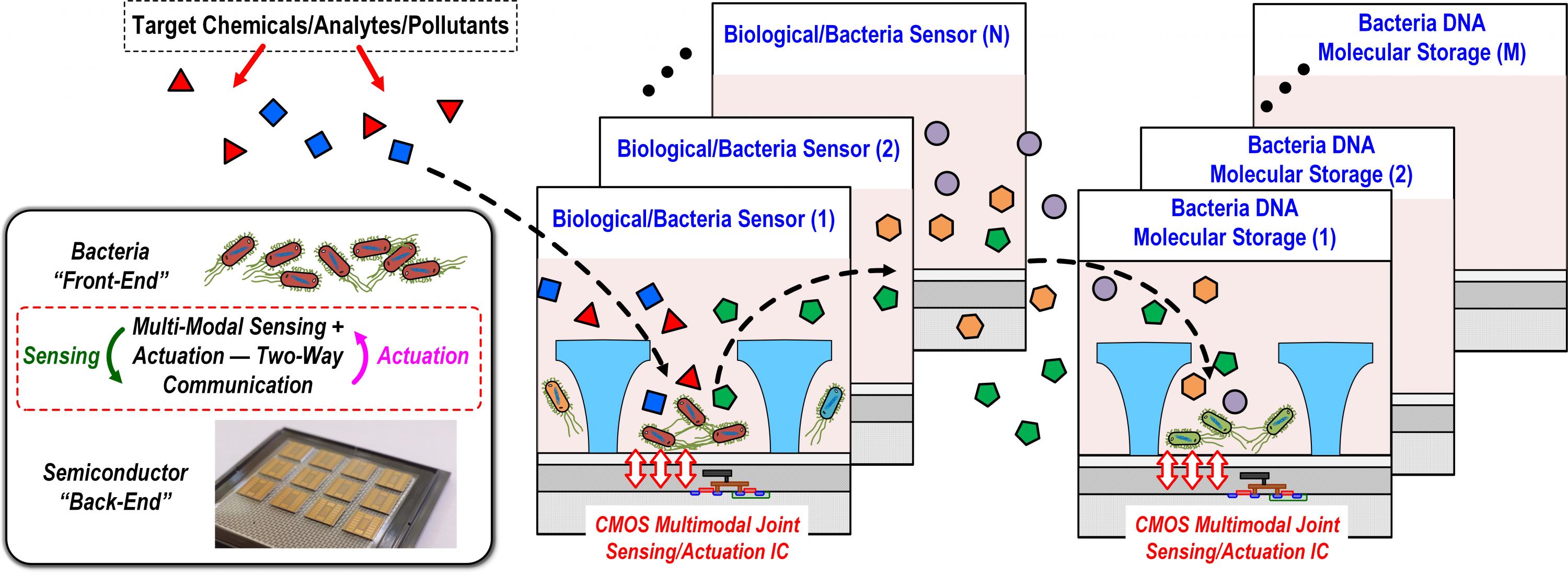A team of researchers from the Georgia Institute of Technology and the Massachusetts Institute of Technology (MIT) have received a three-year, $1.5 million grant for their project entitled “SemiSynBio-II: A Hybrid Programmable Nano-Bioelectronic System.” The target applications for this technology are environmental monitoring and healthcare.
Living cells are equipped with highly versatile built-in toolkits of DNA, RNA, and proteins for molecular communication, computing, storage, and sensing/actuation in response to environmental stimuli. Synthetic biology has been remarkably successful in developing engineered living cells by harnessing the same biological toolkits with enhanced natural functions or new human-defined functions.
According to Hua Wang, an associate professor in the Georgia Tech School of Electrical and Computer Engineering (ECE) and the project PI, these engineered cells can potentially serve as a “biological frontend” layer that naturally interfaces with the environment and acts as biosensors/actuators, molecular computing platforms, and molecular memory. In parallel, with decades of unprecedented technological advances, semiconductor technologies, such as Complementary-Metal-Oxide-Semiconductor (CMOS) integrated circuits (ICs), can be employed as a “semiconductor backend” layer to interface with the living cell “biological frontend” layer for a wide variety of real-time control, communication, and computation functionalities.
“This project aims to advance the science and develop a first proof-of-concept programmable living nano-bioelectronic system that harnesses both the exquisite synthetic functionalities of engineered bacteria and the full functionalities of the ultra-low-power CMOS integrated circuit chips,” Wang said.
To develop this system, various bacteria strains will be engineered to perform wide-spectrum chemical sensing, such as heavy metal detections, in-bacteria DNA-based storage of analog/digital information, and molecular computation and encoding. CMOS IC chips with on-chip pixelated massively paralleled arrays will also be developed to provide real-time two-way, multi-modal interfaces with the living bacteria, which will read stored sensory information from the bacteria and write control signals to reprogram the living bacteria sensors. The bacteria strains and CMOS ICs will then be packaged together in 3D-printed microfluidics structures.
To address the multi-disciplinary aspects of this project, Wang is teaming with Tim Lu, an associate professor in MIT’s Department of Electrical Engineering and Computer Science; Faramarz Fekri, a Georgia Tech ECE professor; and Brian Hammer, an associate professor in the Georgia Tech School of Biological Sciences. Their roles are as follows:
• Wang and his team in the Georgia Tech Electronics and Micro-System Lab (GEMS) will lead the development of the multi-modal CMOS nano-electronics array IC chips for a two-way bacteria-nanoelectronics interface, as well as the packaging and integration of the hybrid programmable nano-bioelectronic system.
• Lu and the Synthetic Biology Group at MIT will lead the development of synthetic bacteria strains that monitor important analytes, such as chemicals and pollutants, and convert these into analog and digital signals for memory and signal transduction. They will interface with the outside world using convenient optical and/or electrical interfaces.
“Engineered cells provide a natural interface with the living world, and will enable entirely new applications when paired with synergistic electronic systems that can compute and transmit environmental and health information beyond what biology can do on its own,” Lu said.
• Fekri and his Sensing, Processing, and Communication (SPC) Research Lab at Georgia Tech will lead the efforts on bio-computing, as well as signal coding for reliable storage. He will use a stochastic computing framework for computation using cells and will develop data-driven analog code designs for the in-bacteria DNA storage.
Nature is not purely digital and replicating the deterministic digital circuitries in biology is highly complex, according to Fekri. “Instead, we propose to use stochastic computing, which will explore the probabilistic nature of biology for computation,” he said. “Our intent is to demonstrate that bacterial cells engineered with genetically encoded logic gates can be exploited as a platform for stochastic bio-computing.”
• Hammer, from Georgia Tech's Center for Microbial Dynamics and Infection, will provide support and consultation on related biological experimentation and hybrid system integration.
The target application of this system is to create an in-field living nano-bioelectronic sensor for environment monitoring and healthcare, according to Wang. “The project has potentials for long-term, broader impacts on basic science and technology,” he said. “It brings together expertise from synthetic biology, hybrid bioelectronics, integrated packaging, information theory, and computing in a very unique way to further our university research and education.”
Note: This research is, in part, funded by the U.S. Government. The views and conclusions contained in this document are those of the authors and should not be interpreted as representing the official policies, either expressed or implied, of the U.S. Government.
For More Information Contact
Jackie Nemeth
School of Electrical and Computer Engineering
404-894-2906



